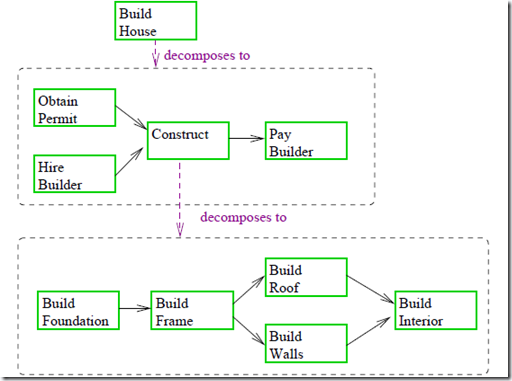In artificial intelligence, the hierarchical task network, or HTN, is an approach to automated planning in which the dependency among actions can be given in the form of networks.
Planning problems are specified in the hierarchical task network approach by providing a set of tasks, which can be:
- primitive tasks, which roughly correspond to the actions of STRIPS;
- compound tasks, which can be seen as composed of a set of simpler tasks;
- goal tasks, which roughly corresponds to the goals of STRIPS, but are more general.
A primitive task is an action that can be executed. A compound task is a complex task composed of a sequence of actions. A goal task is a task of satisfying a condition. The difference between primitive and other tasks is that the primitive actions can be directly executed. Compound and goal tasks both require a sequence of primitive actions to be performed; however, goal tasks are specified in terms of conditions that have to be made true, while compound tasks can only be specified in terms of other tasks via the task network outlined below.
Constraints among tasks are expressed in form of networks, called task networks. A task network is a set of tasks and constraints among them. Such a network can be used as the precondition for another compound or goal task to be feasible. This way, one can express that a given task is feasible only if a set of other actions (those mentioned in the network) are done, and they are done in such a way that the constraints among them (specified by the network) are satisfied. One particular formalism for representing hierarchical task networks that has been fairly widely used is TAEMS.
A task network can for example specify that a condition is necessary for a primitive action to be executed. When this network is used as the precondition for a compound or goal task, it means that the compound or goal task requires the primitive action to be executed and that the condition must be true for its execution to successfully achieve the compound or goal task.
The best-known domain-independent HTN-planning software is:
- Nonlin, one of the first HTN planning systems.
- SIPE-2
- O-Plan
- UMCP, the first provably sound and complete HTN planning systems.
- SHOP2, a HTN-planner developed at University of Maryland, College Park.
HTN is a useful way to provide the planning engine with information about the hierarchical structure of the planning domain. HTN-like planning (as it is practically used) has the same expressivity (i.e. can solve the same domains) as STRIPS. The theoretical model of HTN is strictly more expressive than STRIPS, but cannot be directly used because of its undecidability.
Example of HTN:
